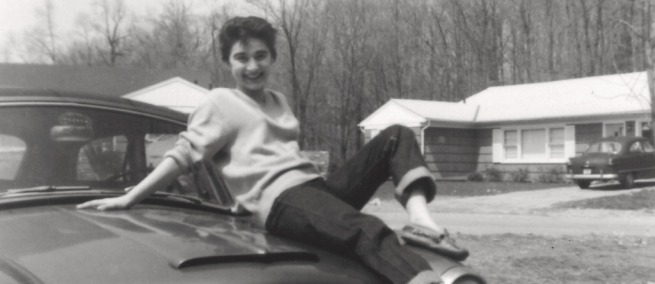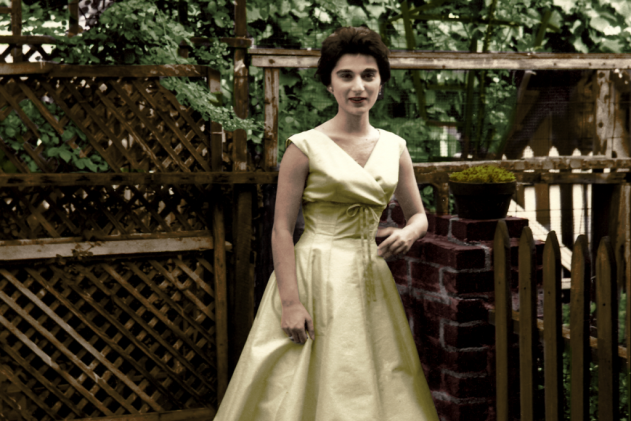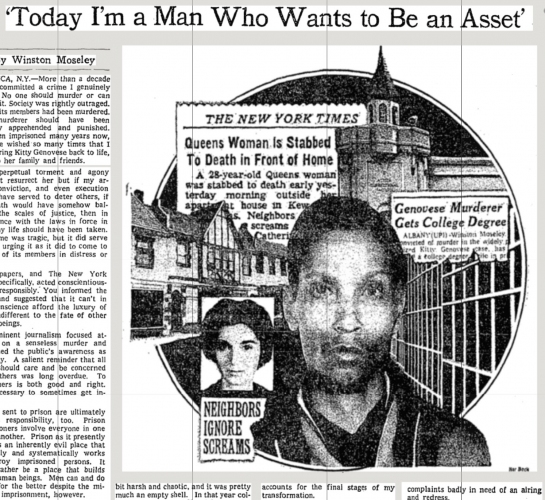
The death of Winston Moseley on March 28, 2016, who murdered Kitty Genovese in 1964, has coincided with a remarkable convergence of media attention focusing on the case. 28-year-old Kitty Genovese, a resident of Kew Gardens in Queens, was walking home late one night, as she often did, from her job as a bar manager when she was attacked and stabbed multiple times. Her assailant, Moseley, was scared off after the first attack and Genovese managed to drag herself into the vestibule of her apartment building, only to be re-asaulted by Moseley and ultimately killed. According to an article published later in The New York Times, 37 residents in her apartment complex saw the attack and did not intervene. Because no one called the police, the residents were deemed apathetic. “Anger is directed, not toward the crime, nor the criminal, but toward those who failed to halt the criminal’s actions,” The Nation reported in 1964.
The Kitty Genovese case became so famous that it was catalogued in most psychology textbooks and taught in schools. Termed the “Bystander effect,” or “Genovese Syndrome,” textbook authors wrote that there is a diffusion of responsibility and subsequent lack of action when multiple people are present. This has been a topic of interest to psychologist Phillip Zimbardo, whose controversial research into obedience is chronicled in the Sloan-winning film THE STANFORD PRISON EXPERIMENT.
The assimilation of the Genovese case into the field of social psychology has since been called into question. Is it the case that no one called the police? Were there really 37 eyewitnesses? Kitty Genovese’s younger brother, William, takes these questions on in a documentary called THE WITNESS, directed by James Solomon. In the documentary, Genovese corresponds with Moseley in jail, and meets with his son, who is now a pastor. THE WITNESS also tries to draw out a fuller history of Kitty’s life—as one of five children who was beloved by her high-school classmates, her siblings, her roommate with whom she had a lesbian relationship, and those at the bar where she worked.
Despite subsequent evidence that there were not, in fact, 37 eyewitnesses to Genovese’s murder, the research on the Bystander effect has withstood time. Screenwriter Robert Cohen wrote a script for a narrative feature film, BYSTANDER, about the Bystander effect funded by NYU and the Sloan Foundation, which was then developed at the Hamptons Screenwriters Lab and won the Tribeca Film Institute’s Student Grand Jury Prize. Cohen is now a staff writer for LAW & ORDER: SVU. An episode which aired on February 3, “41 Witnesses,” was based on his script, BYSTANDER. Science & Film spoke with Cohen at the Museum of the Moving Image about the psychology in the Genovese case and the process of adapting his screenplay into a television episode.
Science & Film: Who first coined the term Bystander effect?
Robert Cohen: Bibb Latané and John Darley pioneered that research and published the first study on bystander apathy four years after her murder, and while they were inspired by Kitty’s story, they were not directly involved in the case. I fictionalized it in my script BYSTANDER and thought it would be interesting to write about characters who were right there, who get involved with the witnesses, the police, and the media in the immediate aftermath.
Over time, that script has been evolving. I want to keep the psychologists’ part of the story, but the more I learn about the case and its repercussions, the more it feels like a sociological study of a city. I don’t want to only study the psychologists. I want to write more about Kitty and her life, her partner, her neighbors, what their relationships were, and about the police. Now that I have gotten so involved in SVU I am really interested in the crime aspects of it, the police procedural stuff, and the justice system and how that affected what happened and then how the media made it into the story that it is.
S&F: Which in turn affected the psychology–
RC: Exactly. It wasn’t really the story that it is today. It wasn’t like the first article about the murder was the piece on 37 witnesses. That was two weeks later, and then it sort of spiraled. It wasn’t immediately apparent that it was a story about bystander inaction, and there are some interesting things about the way the police dealt with it, and then the way the police dealt with the media, that led it to becoming that kind of a story.

S&F: When you were writing the script, what aspects of the psychology did you want to focus on?
RC: There was an experiment in the script, “The Smoke-Filled Room Experiment.” That was a replication study, not actually one that Darley and Latané did. People fill out a questionnaire in a room, then smoke starts filling into the room. The experiment is to see how long it will take for people to go tell someone there is smoke in the room. When there is one person alone in the room they typically go out almost immediately. In another trial, there are six people in the room and five are paid confederates of the study. One person is the real subject, and the confederates don’t react and keep filling out the form and in that case, most of the participants don’t do anything–or if they do, it takes significantly longer to get help.
The study Darley and Latané did was: people are on the phone doing an “interview” and then the interviewer starts coughing and making sounds like he is in distress or having a seizure, and then stops talking and goes silent. The experiment is how long will it take for them to go get help? They know he is down the hall. Some of the people think they alone are talking to him, and then other people think they’re on a conference call with three to five others. Studies typically find that when there is only one subject they go and help a lot faster than in the other scenarios–and the more people on the line, the less likely they are to get help at all.
With the science advisor I went through the procedures of those kinds of experiments, and what would have been done. He also helped me with stuff like: the politics of a psychology department and how this guy got the research going; would he get funding for it; is it something the department would want him to study because it was sort of political because it was based on this infamous story? The advisor also helped me figure out the process for getting a study going in the 60s, who would need to approve it, why it would be difficult, and what kind of an investment it would be. I studied psychology as an undergrad but I didn’t know how a department worked or how it would have worked in the 60s.
S&F: What reportedly happened in the Genovese case has since been debunked, but it has led to studying this psychological phenomenon, the Bystander effect, which holds.
RC: As I have been writing this script I have gone through an evolution of, “oh, this is a story about people who didn’t help her and why,” and then each draft has gotten more realistic about what really happened because I have learned more. The myth is debunked but there are things about it that are still true. There are people who didn’t really see enough to have helped, but there are people in that 37 who really did see something and should have said something: the super at the building across the street, who saw her getting attacked and then went to sleep; Karl Ross, her friend, who basically saw the whole thing, climbed out the window to his neighbor’s, and then he made a few phone calls including to the police, but it was too late; there was another woman who called right away, but she was in the country illegally and didn’t speak much English, and when they asked her who she was she hung up and then the police didn’t respond. The police were partially to blame, but they were not going to tell the Times that, so they emphasized the neighbors who did nothing.
S&F: I watched the SVU episode “41 Witnesses.” Can you talk about the process of adapting your screenplay into that episode?
RC: The two head writers on the show had read an early draft of my script as my writing sample. Two or three years later we were seeing all these stories about witness inaction because it is happening all the time, and eventually they said, why don’t we do a modern day Kitty Genovese episode?—find some stories that are similar and we’ll mash it up. They assigned it to me. There was a story in the fall about three homeless teenagers in Chinatown who dragged a woman out of an internet café to her home, she was on Ketamine, and they assaulted her in a stairwell. Then they went up to her apartment and tried to rob her, but got scared away very quickly. They were caught the next day because they were on all these security cameras. A lot of people were there along the way—between the café and the stairwell and then in the building–a lot of people saw this but nobody called the police until she did, when she got free. We took that crime and added the witnesses in the style of what happened to Kitty, and tried to design the episode around needing to rely on the witnesses to make a legal case.
S&F: When I first saw the episode I thought it was crazy that you had made Kitty into a very unsympathetic character. I didn’t realize it was based on a true story.
RC: We talked a little bit about doing a real modern day Kitty Genovese-style episode. The actual crime, the way that case went, it just wasn’t really a LAW & ORDER-type case. In the real case Moseley was a serial rapist and confessed right away. If there were a serial rapist in Queens and no one was helping today, that would be a bigger thing–a national story, a manhunt–and we’d catch him much more easily with DNA. So we wanted to take something that felt a little more like what could happen now. Her character was not based on Kitty. The crime and the people involved were not taken from the Kitty Genovese story, the overlap was really in the part about the witnesses and the Bystander effect.
S&F: The way technology is used in “41 Witnesses” plays such a big role.
RC: Yeah, we did want to update the technological aspects. A lot of the cases we have been looking at, not just that one, involved people taking video of an assault on their phone and then still not calling the police. The police now, one of the first things they do, is they try to find people with actual footage of the crime because they know a lot of people in the area might have it and they might not offer it up.
S&F: That’s like the modern day version of the Bystander effect.
RC: It’s even crazier because someone has the footage, but still doesn’t come forward.
S&F: I read that the Kitty Genovese case led to the founding of “911”?
RC: Yes, that’s another thing. There was no 911 at the time. The police operated differently; it wasn’t easy to call the police. People got in trouble when they called the police, people thought, “I don’t want to get involved because something might happen to me…” that was worse back then than it is now. Like the woman who did call and hung up because she was undocumented. People might not have wanted the police to start asking them questions. It was known in the community that Kitty and her partner Mary Ann were together, but not by the police. They interrogated Mary Ann the next day after the murder thinking she did it because that was their only lead–it’s usually the partner. They actually said stuff to her like, “you know, gay people are more likely to get jealous.” The person she loved had just died and she had been asleep and she must have felt so guilty. The fact that they were lesbians contributed to the police thinking she did it. It was a different time.
S&F: But even now that it is supposedly so much easier and safer, we still see the Bystander effect.
RC: I think it is better now but that effect still holds. Technology has definitely helped make things safer–DNA evidence, security, and traffic cameras everywhere, police databases like CODIS and COMPSTAT–but in some ways that can increase the bystander effect because people feel even less responsibility to intervene themselves. A.M. Rosenthal, the executive editor of The New York Times at the time, he wrote a book about the whole case called Thirty Eight Witnesses, and I felt he sort of acknowledged that the way they reported the story wasn’t exactly true, but there is a greater truth that the world needed to know and that was why they wrote the story. And I think he knew that when they wrote it. I think he knew what kind of effect it would have, things in the story they exaggerated or highlighted or didn’t highlight, but he wanted that conversation to happen.

S&F: Kitty’s killer, Winston Moseley, wrote an Op-Ed in The New York Times in 1977, where he said, “the crime was tragic, but it did serve society, urging it as it did to come to the aid of its members in distress or danger.”
RC: I don’t agree with what he did, but he is not wrong that it led to those things. He is an interesting character because he’s really smart. His whole trial, he admitted he killed her among other people, and admitted to rapes the police didn’t even know about. He plead insanity–the jury was asked if he knew what he was doing, or whether it was the act of a crazy man. All the witnesses had to testify about exactly what they saw so they could determine whether it was a calculated and logical attack or if it was deranged. The jury concluded that it was logical, because he did all these smart things during it. He waited until there was no one around, he followed her at the speed limit, he wore gloves and a mask, he stabbed her in the throat because she was screaming–it is terrible. That was the prosecution’s argument, that he knew what he was doing and wanted to get away with it.
S&F: Are you still interested in writing about this case?
RC: I want to write a miniseries, because I now think there is more here than a movie. Something like THE WIRE: compressed into five episodes instead of five seasons, where each episode is from different angle—the police, the media, the neighbors, the lawyers, the psychologists. Just in the past few weeks there has been THE PEOPLE V. OJ SIMPSON, CBS and NBC just picked up true crime fictionalized shows, this series is going to get made.
The Museum of the Moving Image will host a preview screening of James Solomon’s documentary THE WITNESS on May 26, before it is released into theatres on June 3.
FILMMAKERS
PARTNERS
TOPICS